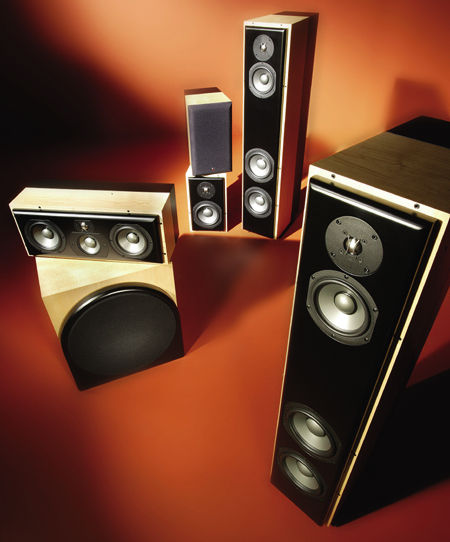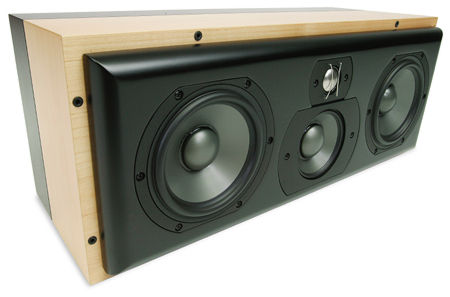Revel Performa surround speaker system

In 2000, Revel debuted their Performa line, which incorporated much of the proprietary technology from the Ultima series, but at lower prices. Now Revel has introduced the second generation of Performa speakers, which promise additional technical refinements at even lower prices.
But the $11,295 question is whether these latest Performa speakers can deliver the sonic goods that their predecessors did. Here's hoping that trickle-down technology is more successful than trickle-down economics.
Revelutionary Technology
Most speaker makers are little more than makers of cabinets and stuffers of boxes. Even some of the most renowned speaker manufacturers buy their components from other companies, which specialize in making drivers and crossovers. Sure, each maker may have specified some modifications that make their parts slightly different from others; more often, the parts in one make of speakers can be found in other brands.
Not so with Revel, which is among a small minority of companies who design most of their own components. The relatively small firm can afford such a maverick approach because it's owned by Harman International; Revel shares test and prototype fabrication facilities with the other Harman-owned speaker companies, Infinity and JBL. In 2000, I visited Revel's factory and the shared test facilities. I was impressed, not only by the physical plant but also by Revel's ability to critically test and optimize their drivers, crossovers, and cabinets. Most other companies must make do with more primitive, less rigorous methodologies to create and build their speakers.
The new Performa F32, C32, and M22 speakers share the same tweeter, midrange, and midrange/woofer driver construction. Unlike the Performa F30, C30, and M20, which used inverted aluminum-alloy speaker domes for their midranges and woofers, the new Performas use an organic ceramic composite material developed by Revel to reduce midband distortion.
Each of the new drivers has two neodymium magnets with opposite polarities that are placed at the center of the driver's motor structure. This arrangement improves the magnetic shielding and reduces extraneous magnetic fields. A new aluminum flux-stabilization ring provides a consistent magnetic field regardless of the voice coil's position in the gap, which lowers distortion over the driver's entire dynamic range. The spider, which attaches the driver to the speaker frame at the base of the cone, is of high-strength Nomex. Revel's tests show that Nomex's superior strength translates into increased linearity, as well as more resistance to fatigue and possible failure.
The Revel's newly developed tweeter combines wide dispersion with excellent power handling, due to its ferrofluid cooling and copolymer surround construction. Designed using laser interferometry to maintain true pistonic behavior up to 20kHz without breakup, its pure titanium dome combines excellent rigidity and density with minimum weight. The only disadvantage of titanium is its fragility—one poke of a wayward finger can irrevocably deform the dome. The Performas' domes are protected by a pair of silver-colored wire guards.
To minimize resonances, the Performas' cabinets have walls of 1-inch-thick MDF and extensive internal bracing. The edges of the front baffles are rounded to reduce high-frequency diffraction effects. Available in black ash, cherry, or maple veneers, the speakers have removable grilles that feature a lightweight plastic frame with curved edges to further minimize sonic reflections. The F32 can accept floor spikes or rounded end supports, both included. The F32 and C32 can be biwired or biamped, and all three models sport gold-plated 5-way binding posts.
The Performa F32 served as the front right and left speakers of the review system. A true 3-way design, the F32 has a 1-inch tweeter, a 5.25-inch midrange, and two 6.5-inch woofers. The crossover uses high-order filters set at 220Hz and 2.8kHz, with separate boards for each frequency range to prevent interference between filter-network components. Each crossover is hand-tuned to match a reference standard to within 0.5dB throughout its entire frequency range, and offers three adjustable low-frequency compensation settings—Normal, Contour, Boundary—as well as tweeter-level settings in 0.5dB increments from –1dB to +1dB.
The F32 has a large, tuned, rear-firing port to augment its bass extension. The F32 is only 8.75 inches wide in front—substantially narrower than its predecessor, the F30. This, coupled with its tapered width, mean that the F32 can fit into smaller rooms with more placement options than could the F30.

The Performa C32 center-channel speaker shoehorns a 3-way design into a surprisingly compact sealed enclosure. With its 1-inch tweeter, 3.5-inch midrange, and two 5-inch woofers, the C32 looks deceptively small atop a direct-view monitor or under a projection screen. Along with a tweeter-level control similar to the F32's, the C32 has a 3-way switch that alters its equalization to compensate for placement atop a monitor, below a screen, or flush-mounted on a front wall. Revel also makes an optional pedestal stand for the C32.
The 2-way Performa M22 surround speaker has a 1-inch tweeter and a 6.5-inch midrange/woofer. Like the larger F32, which it resembles, the M22 has a 1-inch-thick MDF cabinet, tapered sides, and a rear-firing port, as well as similar crossover controls to adjust for placement and tweeter output. The M22's base has four threaded inserts so it can be bolted to Revel's dedicated optional floor stands; it can also be mounted flush to a wall or cabinet.
The Performa B15 was one of the subwoofers included in Part 1 of "Way Down Deep," Stereophile Ultimate AV's subwoofer survey, in the June 2004 issue, and the B15a differs only in cosmetics. It's rated for a maximum output of 113dB at 20Hz and 126dB at 30Hz. The single 15-inch driver has a 3-inch, 4-layer voice coil, dual-laminated Kapton former, a 130-oz magnet system, dual complementary spiders, a cast-aluminum frame, and a linear excursion of 2.5 inches peak-to-peak.
With a 1000W RMS amplifier capable of 1400W peaks, a thermal protection circuit, and three independent parametric equalizers with variable frequency, bandwidth, and level controls, the B15a is a take-no-prisoners subwoofer design. While those who judge subwoofer quality solely in terms of output may wonder whether the inclusion of three independent bands of parametric EQ is some sort of gimmick, it actually makes it possible for the B15a to outperform most of its competition in real-world situations: the user can optimize its output to work with a specific room's strengths and weaknesses.





























































